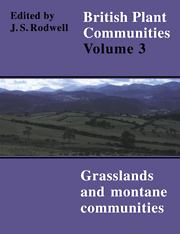Book contents
- Frontmatter
- Contents
- List of Figures
- Preface and Acknowledgements
- Preamble
- Mesotrophic Grasslands
- Community Descriptions
- Calcicolous Grasslands
- Community Descriptions
- Calcifugous Grasslands and Montane Communities
- Community Descriptions
- Index of Synonyms to Grasslands and Montane Communities
- Index of Species in Grasslands and Montane Communities
- Bibliography
General Introduction
Published online by Cambridge University Press: 04 July 2020
- Frontmatter
- Contents
- List of Figures
- Preface and Acknowledgements
- Preamble
- Mesotrophic Grasslands
- Community Descriptions
- Calcicolous Grasslands
- Community Descriptions
- Calcifugous Grasslands and Montane Communities
- Community Descriptions
- Index of Synonyms to Grasslands and Montane Communities
- Index of Species in Grasslands and Montane Communities
- Bibliography
Summary
The background to the work
It is a tribute to the insight of our early ecologists that we can still return with profit to Types of British Vegetation which Tansley (1911) edited for the British Vegetation Committee as the first coordinated attempt to recognise and describe different kinds of plant community in this country. The contributors there wrote practically all they knew and a good deal that they guessed, as Tansley himself put it, but they were, on their own admission, far from comprehensive in their coverage. It was to provide this greater breadth, and much more detailed description of the structure and development of plant communities, that Tansley (1939) drew together the wealth of subsequent work in The British Islands and their Vegetation, and there must be few ecologists of the generations following who have not been inspired and challenged by the vision of this magisterial book.
Yet, partly because of its greater scope and the uneven understanding of different kinds of vegetation at the time, this is a less systematic work than Types in some respects: its narrative thread of explication is authoritative and engaging, but it lacks the light-handed framework of classification which made the earlier volume so very attractive, and within which the plant communities might be related one to another, and to the environmental variables which influence their composition and distribution. Indeed, for the most part, there is a rather self-conscious avoidance of the kind of rigorous taxonomy of vegetation types that had been developing for some time elsewhere in Europe, particularly under the leadership of Braun-Blanquet (1928) and Tüxen (1937). The difference in the scientific temperament of British ecologists that this reflected, their interest in how vegetation works, rather than in exactly what distinguishes plant communities from one another, though refreshing in itself, has been a lasting hindrance to the emergence in this country of any consensus as to how vegetation ought to be described, and whether it ought to be classified at all.
In fact, an impressive demonstration of the value of the traditional phytosociological approach to the description of plant communities in the British Isles was published in German after an international excursion to Ireland in 1949 (Braun-Blanquet & Tüxen 1952), but more immediately productive was a critical test of the techniques among a range of Scottish mountain vegetation by Poore (1955a, b, c).
- Type
- Chapter
- Information
- British Plant Communities , pp. 3 - 14Publisher: Cambridge University PressPrint publication year: 1992

